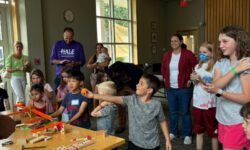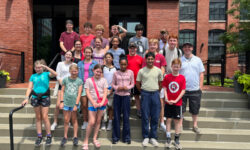[ccfic caption-text format="plaintext"]
By James Kinneen
Hometown Weekly Reporter
With schools increasingly trying to lead children to STEM careers, there is a huge need to make engineering seem as fun as long-beloved subjects like art and music.
Looking to fill that gap, Jay Mankita brought his Rube Goldberg machine building event, Playful Engineers, to the Sherborn Community Center.
In a room filled with kids of all ages, Mankita first showed off his ping pong ball launching device, constructed out of ramps, popsicle sticks, threaded rods, and wooden blocks. As the ball rolled down the various parts of the machine, he called out what techniques were being deployed until the ball popped into the air, and he failed to catch it.
This may have been intentional, though, as with the crowd convinced they could replicate his accomplishment, Mankita told the kids not to worry about failure, quoting MythBusters’ Adam Savage and declaring: “failure is always an option.”
From here, the kids used worksheets to utilize Rube Goldberg techniques like the threaded rod spiralator, popsicle stick catapult, rolling cone, and Tinkertoy carousel and create whatever they wanted to make.
Why not have a teacher stand in front, and guide them step by step on creating a uniform machine? According to Mankita, a longtime children’s concert singer who created Playful Engineers when his son became interested in physics and engineering, that would have defeated the purpose.
“Formative assessment is one of the new catchwords in education,” he explained. “The idea that, rather than testing at an end of a subject and then giving a grade, you are creating an environment where the kids can learn and do and test and learn and do and test, as they’re going along. It’s a much more efficient way to learn experientially, so this environment has almost 100 percent engagement among the participants, including the adults, preschoolers and the high school students - whoever shows up - because it fills a gap between tech-heavy science and engineering education and something with no science education. Making things move is something that has immediate gratification. There are lots of opportunities for lots of successes and failures in small doses, so it’s easier to take and loads of fun.”
If all this talk about embracing failure has you nervous the kids weren’t having fun, don’t worry. Even if the devices weren’t working properly, the kids had fun just stacking wooden blocks and building ramp towers. And when one of the children’s machines did what they wanted, their sense of accomplishment was evident on their faces.
This was by design. Mankita stressed the idea that having fun was the goal, and to that end, having the kids be in charge is the best way to accomplish that.
“The word ‘playful’ being in Playful Engineers is very deliberate, because that’s the bottom line. We all want our kids to have a fun childhood, so even though there’s so much learning in this, it’s not about teaching as much as playing and acknowledging the biological imperative that children must learn, and they must do that through learning. If they can do that through play, all the better.”
As far as age limits, knowledge bases or any other prerequisites for Playful Engineers, Mankita had one request: “I don’t want to work with anyone that will eat my materials.”
While Mankita gave kids the opportunity to create complex machines, the point was about having fun; he continually emphasized that there’s nothing wrong with failing.
So, next time you see a Playful Engineers event, be sure to go. As long as you don’t eat Jay Mankita’s stuff, you can’t fail.























